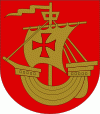Taivassalo
 |
The municipality is unilingually Finnish. Its neighboring municipalities are Kustavi, Masku, Mynämäki, Naantali, Uusikaupunki and Vehmaa.
The medieval sailing ship appearing in the coat of arms of Taivassalo refers to the maritime connections the coastguard already had during the Northern Crusades, as well as to the medieval naval weaponry, the surviving information of which comes from Taivassalo itself. The coat of arms was designed by Olof Eriksson, and the Taivassalo municipal council approved it at its meeting on October 21, 1953. The Ministry of the Interior approved the coat of arms for use on February 11, 1954.
Taivassalo literally means "sky island", however J. A. Lopmeri and Elias Lönnrot theorized that the initial word was originally taival/taipale, as the area was originally an island, by the time of the naming it may have been connected to the mainland by a thin isthmus (taipale) as a result of post-glacial rebound. The Swedish name Tövsala is an adaptation of the Finnish name.
Map - Taivassalo
Map
Country - Finland
 |
 |
| Flag of Finland | |
Finland was first inhabited around 9000 BC after the Last Glacial Period. The Stone Age introduced several different ceramic styles and cultures. The Bronze Age and Iron Age were characterized by contacts with other cultures in Fennoscandia and the Baltic region. From the late 13th century, Finland became a part of Sweden as a consequence of the Northern Crusades. In 1809, as a result of the Finnish War, Finland became part of the Russian Empire as the autonomous Grand Duchy of Finland, during which Finnish art flourished and the idea of independence began to take hold. In 1906, Finland became the first European state to grant universal suffrage, and the first in the world to give all adult citizens the right to run for public office. After the 1917 Russian Revolution, Finland declared independence from Russia. In 1918, the fledgling state was divided by the Finnish Civil War. During World War II, Finland fought the Soviet Union in the Winter War and the Continuation War, and Nazi Germany in the Lapland War. It subsequently lost parts of its territory, but maintained its independence.
Currency / Language
| ISO | Currency | Symbol | Significant figures |
|---|---|---|---|
| EUR | Euro | € | 2 |
| ISO | Language |
|---|---|
| FI | Finnish language |
| SV | Swedish language |
















